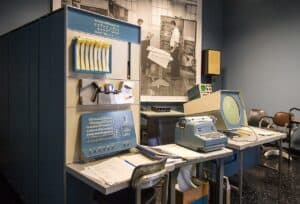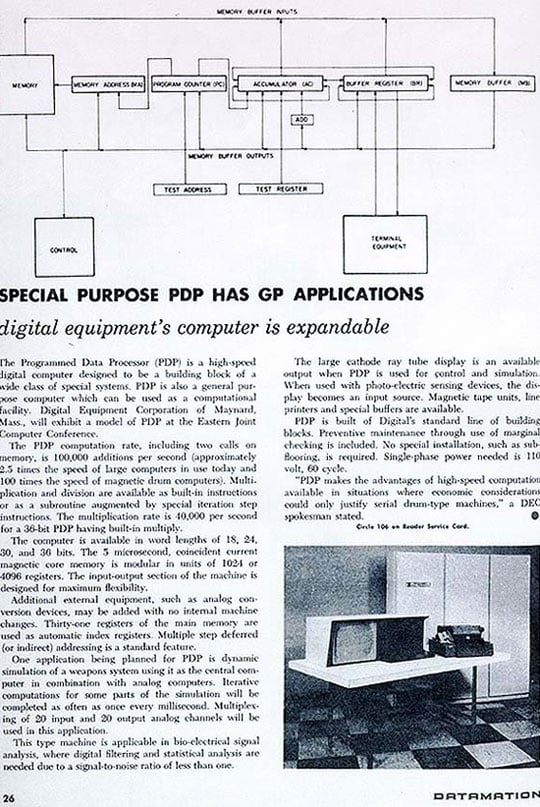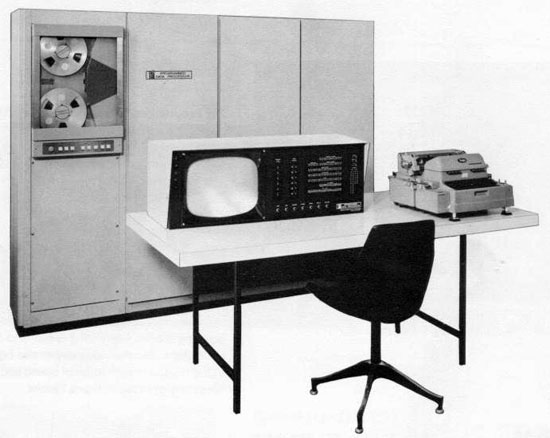
PDP-1
©Alexey Komarov, CC BY-SA 4.0, via Wikimedia Commons – Original / License
4 Facts About PDP-1
- The PDP- 1 is well-known for being the computer that played the most essential role in the development of hacker culture at MIT and BBN.
- The PDP-1 is the original hardware for playing Steve Russell’s Spacewar!, the world’s first minicomputer game.
- The PDP-1 is famous for being significant in the creation of hacker culture.
- Despite its influence on future computer design, the PDP-1 was a commercial failure for DEC at the time.
PDP-1: History
The PDP-1 is the sixth generation minicomputer that employs micro-alloy transistors. When the PDP-1 (Programmed Data Processor-1) computer went on sale, it marked a significant change in how computers were made. It was the first computer designed to interact with the user rather than run efficiently. It was also the first computer made by Digital Equipment Corporation (DEC).
In 1959, a small and relatively new company (founded in 1957) for logic modules and other laboratory equipment, located in an old woolen mill in Maynard Massachusetts, named Digital Equipment Corporation (DEC), decided to built a computer. Ken Olsen, cofounder of DEC, remembered: We had a dream of interactive computing. Normal computing was considered big, expensive, awesome, beyond ordinary people. Interactive computing was exciting and fun, and people could interact directly with the computer.
Announced in 1960 (first machine was delivered in December, 1959), DIGITAL’s landmark first computer, the PDP-1 (Programmed Data Processor-1), marked a radical shift in the philosophy of computer design: it was the first commercial computer that focused on interaction with the human user rather than the efficient use of computer cycles. Unlike the computers before it, it was centered around the user and actually it was the engineers, researchers, students and hackers from a variety of companies and organizations, that brought DEC’s vision of the PDP-1 to life. The DEC people and the machine they created went on to have wide influence.

DEC management assigned the project to their best engineer and colleague from MIT, Ben Gurley. Benjamin Gurley (1926-1963) was a brilliant engineer and designer, who came in DEC from MIT’s Lincoln Laboratory, just like the founders of DEC—the brothers Ken and Stan Olsen, and Harlan Anderson. While in MIT, Gurley worked on the TX-0 and TX-2 computers created at MIT in the second half of 1950s, thus his computer design work at MIT greatly influenced the development of the PDP-1. The TX-0 and TX-2 computers, designed by Wesley Clark (the creator of the LINC computer), were (besides all) among the first transistor driven computers in the world.
The work on PDP-1 began in the summer of 1959. Gurley formed a group to work on the computer with fellow engineers and former Lincoln Laboratory employees—Ken and Stan Olsen, Dick Best, Bob Savell and Harlan Anderson. Amazingly, Gurley managed to built nearly the entire system himself in three-and-a-half months, making liberal use of DEC’s existing system building block product line—laboratory modules. He once joked that his assignment was “to make [the PDP-1] from inventory.” The truth, however, is that Gurley designed roughly half of the modules used in the PDP-1 from scratch.

The prototype was ready in November, 1959, and the machine was featured in the November/December issue of the magazine Datamation (see the upper image). The article outlining the many features of the new machine generated much advance interest in its appearance at Boston’s Eastern Joint Computer Conference.
The PDP-1 was a solid state digital computer, built mostly of DEC 1000-series System Building Blocks, using Micro-Alloy and Micro-Alloy-Diffused transistors with a rated switching speed of 5 MHz. PDP-1 has an 18-bit word and 4 kilowords as standard main memory (equivalent to 9 kilobytes), upgradable to 64 kilowords (144 kB). The magnetic core memory’s cycle time was 5 microseconds, thus most arithmetic instructions took 10 microseconds (100000 operations per second) because they had two memory cycles: one for the instruction, one for the operand data fetch.
PDP-1 was designed to operate with many types of input-output devices (among them typewriter, paper tape, cathode ray tube, light pen, magnetic tape, etc., see the list bellow) with no internal machine changes.
The PDP-1 was a solid-state digital computer made mostly of Digital Equipment Corporation (DEC) 1000-series System Building Blocks. It mainly employed Micro-alloy and micro-alloy diffused transistors with a switching speed of 5 MHz.
Though the PDP-1 was made in small numbers (about 50), it had a significant impact. Digital Equipment Corporation( DEC) was the start of a long line of computers that were both interactive and cheap. This set the stage for what would become a whole new type of computer: the “minicomputer.” By the middle of the 1960s, the minicomputer industry would be booming, giving more people access to computers than ever before and paving the way for significant new operating systems and interfaces.
The PDP-1 was also used as a time-sharing system for process control, scientific research, and graphical applications.
PDP-1: How It Worked?
It is a single address, single instruction, stored program computer with powerful program features. It supports fully parallel processing and is unusually versatile. It is easy to install, operate and maintain. Conventional 110-volt power is used, neither air conditioning nor floor reinforcement is necessary, and preventive maintenance is provided for by built-in marginal checking circuits.
The PDP-1 used punched paper tape as its primary storage medium. Unlike punched card decks, which could be sorted and re-ordered, paper tape was difficult to physically edit. This inspired the creation of text-editing programs such as Expensive Typewriter and TECO.
The PDP-1 (see the manual of PDP-1) was the first computer in Digital Equipment Corporation’s successful 14-members PDP series (The last model, PDP-16, was launched in 1972. The brilliant PDP-11 was produced up to 1996.). It is famous for being the computer most important in the creation of hacker culture at MIT, BBN and elsewhere. The PDP-1 (with the optional high-resolution graphical display) was also the original hardware for playing history’s first game on a minicomputer, Steve Russell’s Spacewar
Been the world’s first commercial interactive computer, the remarkable PDP-1 was used by its purchasers to pioneer timesharing systems, making it possible for smaller businesses and laboratories to have access to much more computing power than ever before.
The entire computer occupies bellow 2 sq. m. of floor space, dimensions of the system module are 1.5 x 2.5 x 1 m. PDP-1 consists of four equipment frames, one of which is used as the operating station.
Central Processor
The Central Processor contains the control, arithmetic and memory addressing elements, and the memory buffer register. The word length is 18 binary digits. Instructions are performed in multiples of the memory cycle time of five microseconds. Add, subtract, deposit, and load, for example, are two-cycle instructions requiring 10 microseconds. Multiplication requires and average of 20 microseconds. Program features include: single address instructions, multiple step indirect addressing and logical arithmetic commands. Console features include: flip-flop indicators grouped for convenient octal reading, six program flags for automatic setting and computer sensing, and six sense switches for manual setting and computer sensing.
Memory System
The coincident-current, magnetic core memory of a standard PDP-1 holds 4096 words of 18 bits each. Memory capacity may be readily expanded, in increments of 4096 words, to a maximum of 65536 words. The read-rewrite time of the memory is five microseconds, the basic computer rate. Driving currents are automatically adjusted to compensate for temperature variations between 50 and 110 degrees Fahrenheit. The core memory storage may be supplemented by up to 24 magnetic tape transports.
Input-Output
PDP-1 is designed to operate a variety of buffered input-output devices. Standard equipment consists of a perforated tape reader with a read speed of 400 lines per second, and alphanumeric typewriter for on-line operation in both input and output, and a perforated tape punch (alphanumeric or binary) with a speed of 63 lines per second. A variety of optional equipment is available, including the following:
- Precision CRT Display Type 30
- Ultra-Precision CRT Display Type 31
- Symbol Generator Type 33
- Light Pen Type 32
- Oscilloscope Display Type 34
- Card Punch Control Type 40-1
- Card Reader and Control Type 421
- Magnetic Tape Transport Type 50
- Programmed Magnetic Tape Control Type 51
- Automatic Magnetic Tape Control Type 52
- Automatic Magnetic Tape Control Type 510
- Parallel Drum Type 23
- Automatic Line Printer and Control Type 64
- 18-bit Real Time Clock
- 18-bit Output Relay Buffer Type 140
- Multiplexed A-D Converter Type 138/139
All in-out operations are performed through the In-Out Register or through the high speed input-output channels.

The software included diagnostics routines, assembler, debugger, editor, conversion routines for punching tapes, etc.
Despite its importance for the philosophy of computer design and its significant impact, the PDP-1 seems to be a commercial failure for DEC and was produced in relatively small quantities (53 machines, last built in 1969). The initial cost of a fully equipped system was $120000 ($85000 for minimal models), at a time when other computers sold for well over 1 million dollars.
PDP-1: Historical Significance
PDP-1, the sixth generation computer, was the world’s first commercial computer that people could use. The PDP-1 also made it possible for small businesses and labs to get more computing power than ever before.
For the user, the PDP-1 was an unprecedented level of human-machine interaction. This led to hacker culture at MIT, Bolt Beranek and Newman, and other places.
People who bought the PDP-1, the world’s first commercial computer that people could use, used it to start time-sharing systems, making it easier for small businesses and labs to get more computing power than ever before.
The whole computer takes up less than two sq. m. of floor space, and the system module is 1.5 x 2.5 x 1 m. PDP-1 comprises four equipment frames, one of which is used to run the machine.
Expensive Typewriter and TECO
The PDP-1 uses punched paper tape as its primary way to store data. Paper tape can’t be physically changed, unlike punched card decks that could be sorted and re-ordered, but paper tape can’t be changed. This led to programs like Expensive Typewriter and TECO being made. Because it has online and offline printers based on IBM electric typewriter mechanisms, it can print what in the 1980s would be called “letter-quality” documents. This led to the TJ-2, which is thought to have been the first-word processor.
There is a company called Soroban Engineering that makes the typewriter on the console. It is based on an IBM Model B Electric typewriter mechanism that has been changed by adding switches to detect key presses and solenoids to start the typebars. Typebars are used instead of the “golfball” IBM Selectric typewriter mechanism, which didn’t come out for a few more years after that. Letter cases are chosen by raising and lowering the big type basket. In the Soroban, a two-color inked ribbon can be selected (red and black). The interface lets you choose which color you want to use. There are a lot of computer programs that use color-coding so that users can tell what they do with their input from what the computer does. Unfortunately, the Soroban mechanism isn’t very reliable, and it can get stuck when you move the case or change the ribbon color.
Friden Flexowriters are the most common offline devices. They have been made to work with the FIO-DEC character coding that the PDP-1 used. Each of these typewriters is built around a mechanically similar mechanism to an IBM Electric typewriter. Flexowriters, on the other hand, are extremely long-lasting and are frequently employed for long-term printing sessions. In addition, flexowriters have paper tape punches and readers that function with the typewriter operation.
They work together. People type about ten characters per second when they write. In a typical PDP-1 operation, the PDP-1’s “high speed” Teletype model BRPE punch is used to output text to punched paper tape. Then, the paper tape is carried by hand to a Flexowriter for printing.
Later, DEC tape drives were added to some PDP-1 systems to make it easier to back up programs and data and make it easier for people to work together simultaneously. This kind of application usually needs a second storage device that can move programs and data into and out of core memory without manual intervention. Unfortunately, paper tapes aren’t as good as DEC tapes regarding reliability, durability, and speed. Early hard drives were costly and were known to be unreliable. They are used mostly for speed when switching files, not for long-term storage, if they are still working.
Type 30 Precision CRT
The Type 30 Precision CRT display can show 1024 by 1024 points at a rate of 20,000 points per second. It can show 1024 by 1024 points at a rate of 20,000 points per second.
A special “Display One Point On CRT” instruction is used to build up images. These images must be updated many times a second, so this instruction is used. The CRT, made initially for radar, is 19 inches (48 cm) in diameter and has a long-lasting P7 phosphor. It was originally made for radar. A light pen can be used with Type 30 to choose points on the screen. An extra character generator and hardware for creating lines and curves are available.
Music
Hackers at MIT also used the PDP-1 to play music in four-part harmony. They used special hardware, like four flip-flops controlled by the processor (the audio signal is filtered with simple RC filters). Music was written with Peter Samson’s Harmony Compiler, a complex text-based program that has some features that make it easier to write baroque music quickly. In total, a lot of music was made for it, including Bach fugues, the whole of Mozart’s Eine Kleine Nachtmusik, the end of Beethoven’s Symphony No. 9, Christmas carols, and many other songs that people know and love.
PDP-1 Currently
In the Computer History Museum, three PDP-1 computers are still known to be active (CHM). One is the prototype used at MIT, and the other two are real PDP-1C machines. On two Saturdays each month, one of the latter, serial number 55 (the last PDP-1 made), works again and is on display at the museum. It’s also on show and is shown on two Saturdays each month. On a particular page of the Computer History Museum, you can read about how the restoration was done. These demonstrations include these:
PDP emulator of Spacewar! And PDP graphics demonstrate emulators such as Snowflake.
Software simulations emulators of the PDP-1 include Binary image paper tapes of the software in the bitsavers.org archives, and SIMH and MESS have binary image paper tapes of the PDP-1.